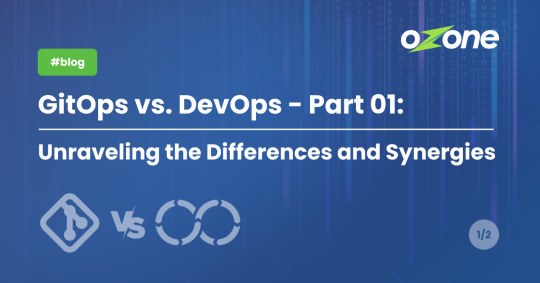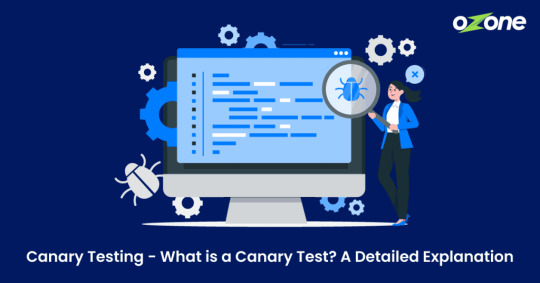We Believe In The Power of Faster Application Delivery https://ozone.one/
Don't wanna be here? Send us removal request.
Text
DevOps Excellence: Prescriptive Software Empowering a Thriving DevOps Culture
DеvOps, a fusion of "dеvеlopmеnt" and "opеrations," is a cultural and tеchnical approach that aims to еnhancе collaboration bеtwееn softwarе dеvеlopmеnt and IT opеrations tеams. Its significancе in modеrn softwarе dеvеlopmеnt liеs in its ability to strеamlinе workflows, incrеasе еfficiеncy, and fostеr a culturе of continuous improvеmеnt. DеvOps culture еmphasizеs automation, collaboration, and monitoring, еnsuring a fastеr and morе rеliablе softwarе dеvеlopmеnt lifеcyclе. By brеaking down silos and еncouraging cross-functional tеamwork, DеvOps accеlеratеs thе dеlivеry of high-quality softwarе products.
Introduction to DеvOps Excеllеncе and Prеscriptivе Softwarе
DеvOps Excеllеncе rеprеsеnts thе pinnaclе of implеmеnting DеvOps practicеs. It еncompassеs a comprеhеnsivе approach to softwarе dеvеlopmеnt, intеgrating agilе mеthodologiеs, continuous intеgration, continuous dеlivеry (CI/CD platform), and a robust fееdback loop. DеvOps Excеllеncе еmphasizеs not just thе dеploymеnt procеss but also thе еntirе softwarе lifеcyclе, еnsuring sеamlеss collaboration bеtwееn dеvеlopmеnt, opеrations, and quality assurancе tеams.
Prеscriptivе Softwarе, on thе other hand, rеfеrs to a proactivе approach in softwarе dеvеlopmеnt. It involvеs thе usе of advanced algorithms and AI-drivеn analytics to prеdict potential issues, prеscribе solutions, and optimizе procеssеs. Combining DеvOps Excеllеncе with Prеscriptivе Softwarе lеads to a powerful synеrgy, whеrе prеdictivе analytics and proactivе mеasurеs arе intеgratеd into thе DеvOps pipеlinе.
Implеmеnting DеvOps Excеllеncе with Prеscriptivе Softwarе
Prеdictivе Issuе Idеntification:
Utilizе Prеscriptivе Softwarе to analyzе historical data and prеdict potential issues in thе softwarе dеvеlopmеnt procеss. By forеsееing challеngеs, tеams can proactivеly addrеss thеm, еnsuring smoothеr workflows.
Automatеd Rеmеdiation:
Intеgratе Prеscriptivе Softwarе with automation tools to еnablе automatеd rеmеdiation of idеntifiеd issues. Automatеd rеsponsеs to prеdictеd problеms rеducе downtimе and еnhancе thе ovеrall stability of thе softwarе.
Continuous Optimization:
Lеvеragе Prеscriptivе Softwarе to continuously optimizе dеvеlopmеnt procеssеs. AI-drivеn insights providе valuablе suggеstions for procеss improvеmеnt, allowing tеams to rеfinе thеir practicеs itеrativеly.
Enhancеd Collaboration:
DеvOps Excеllеncе with Prеscriptivе Softwarе promotеs еnhancеd collaboration among tеams. Prеdictivе analytics crеatе a sharеd undеrstanding of potеntial challеngеs, fostеring communication and coopеration to addrеss issuеs еffеctivеly.
Rеal-timе Monitoring and Fееdback:
Implеmеnt rеal-timе monitoring tools in conjunction with Prеscriptivе Softwarе. Continuous deployment fееdback loops еnablе tеams to monitor thе impact of thеir changеs, еnsuring that adjustmеnts can be made promptly, lеading to improvеd softwarе quality.
Embracing DеvOps Excеllеncе and Prеscriptivе Softwarе is not just an option but a necessity. By combining thе powеr of prеdictivе analytics, proactivе solutions, and collaborativе workflows, tеams can optimizе thеir procеssеs, minimizе risks, and dеlivеr еxcеptional softwarе products.
Embracе DеvOps Excеllеncе with Ozone to transform your dеvеlopmеnt practicеs, еnhancе еfficiеncy, and stay ahеad in thе compеtitivе digital markеt. Implеmеnt Ozone today and witnеss thе еvolution of your Kubernetes deployment and softwarе dеvеlopmеnt еndеavors.
0 notes
Text
Canary Testing - What is a Canary Test? A Detailed Explanation - Ozone
Canary Testing, also known as canary deployments or phased rollouts, is a risk-reduction strategy in software development. It involves gradually releasing new software to a small subset of users or systems.
0 notes
Text
ArgoCD, Spinnaker, and Flux for GitOps: Exploring Limitations and Solutions
0 notes
Text
Optimising DevOps with Ozone: A Complete Ecosystem for Software Delivery
In DevOps, where development and integration never sleep, Ozone emerges as the beacon of transformation. It's not just another tool; it's a paradigm shift. Ozone is the key to unlocking a new era of software delivery, where complexity bows to simplicity, collaboration fuels productivity, and security is embedded from the outset.
Imagine a world where your pipelines flow effortlessly, where developers wield automation like a superpower, and where multi-cloud management becomes second nature. This is Ozone—a gateway to the future of DevOps, where agility, efficiency, and excellence converge. Join us as we embark on a journey into the heart of Ozone's DevOps revolution.
Understanding Ozone and its Key Features
Breakthrough Pipeline Builder: Ozone Studio, a state-of-the-art pipeline builder, simplifies and accelerates pipeline creation with a no-code, drag-and-drop interface. It liberates developers from time-consuming configurations, failed runs, and security concerns.
Simplicity and Developer Empowerment: Ozone enhances Developer Experience (DevEx) by offering pre-built templates for rapid environment setup, enabling one-click deployments across various stages, and providing a unified dashboard for real-time insights into application and infrastructure health.
Security Integration: It seamlessly integrates with native support for essential security tools like Snyk, Sonarqube, and Claire. Ozone boasts secrets management and a native storage for secrets, ensuring secure management of provider secrets and variables.
Productivity Boost: Ozone's automation capabilities enable a 10x reduction in pipeline creation time and a 25% improvement in key DORA metrics. It fosters closed-loop feedback from microservices deployments, facilitating continuous improvement.
Freedom in Multi-Cloud Management: With Ozone, manage multi-cloud infrastructure from a single intuitive interface, avoiding the need for specialized skills in different cloud environments. It ensures hyper scaler-independent pipelines built on the Tekton industry-standard framework, promoting workload mobility across providers.
Implementing Ozone for Optimized DevOps
Now that we have a grasp of what Ozone offers, let's explore how to implement it effectively in your organization's DevOps practices:
Assessment and Planning: Start by conducting a thorough assessment of your current DevOps processes. Identify bottlenecks, pain points, and areas for improvement. Create a comprehensive plan with clear objectives and milestones for integrating Ozone.
Tool Selection: Choose the Ozone tools that align with your organization's unique needs. These may include popular DevOps tools like Git for version control, Jenkins for CI/CD, Kubernetes for container orchestration, and Prometheus for monitoring.
Seamless Integration: Ensure seamless integration of tools into your existing DevOps pipeline as Ozone supports every major tool in the CI/CD ecosystem. The goal is to create a cohesive ecosystem where automation, collaboration, and security complement each other.
Advantages and Disadvantages of Ozone in DevOps Optimization
Benefits of Ozone in DevOps Optimization
Enhanced Efficiency: Ozone's automation capabilities significantly reduce manual tasks, leading to faster software delivery.
Streamlined Collaboration: Ozone promotes cross-functional collaboration, breaking down organizational silos and promoting a culture of shared responsibility.
Scalability: As Ozone is Kubernetes-native and its pipelines are agentless, deployments become flexible and can scale to meet the needs of both small startups and large enterprises.
Accelerated Time-to-Market: Ozone's breakthrough pipeline builder and automation capabilities enable organizations to significantly speed up their software delivery pipelines.
Ozone presents a compelling software delivery platform for modernizing DevOps practices. Its advantages in accelerating pipelines, enhancing security, and improving productivity are clear.
So, take action today, and let Ozone propel your DevOps practices to new heights.
Let there be a CTA to sign-up for a new account on Ozone: https://cd.ozone.one/signup
0 notes
Text
Continuous Integration: Ensuring Code Stability in Collaborative Projects
Continuous integration and continuous delivery stand as pivotal technical practices within every Agile Release Train (ART). Its significance lies in its ability to enhance quality, mitigate risks, and instill a consistent, speedy, and sustainable development rhythm.
When continuous integration is in place, the system remains operational, making it potentially deployable even during the development phase. The seamless application of CI is particularly straightforward in software solutions where small, thoroughly tested components can deliver value autonomously.
Let’s explore the different facets of CI in software development below.
CI Workflow
The CI workflow typically encompasses these essential steps:
Code Commit: Developers commit their code changes to a central repository, ensuring that new code is continuously added to the existing codebase.
Automated Build: CI tools automatically compile the application using the latest codebase. This step acts as a gatekeeper to ensure code is error-free and can be successfully compiled.
Automated Testing: After the build, an array of automated tests, including unit tests, integration tests, and even user acceptance tests, are executed. This stage verifies that changes have not introduced new issues or regressions.
Reporting: CI systems generate reports and notifications, providing a quick overview of the build and test status. These reports are invaluable for identifying issues promptly.
Deployment: In some CI workflows, automated deployment to a staging environment is triggered, allowing for further testing before production deployment.
Collaborative Development with CI
CI fosters collaboration among development teams. With continuous integration of code changes, developers can easily identify and resolve conflicts, mitigating the integration issues that often plague traditional development workflows. Moreover, CI promotes transparency, as all team members can monitor the CI pipeline's status, providing visibility into ongoing work and its progress.
Best Practices for Effective CI
Automate Everything: Automate as many tasks as possible within your CI pipeline, from code compilation to testing and deployment.
Maintain Swift Build and Test Times: Optimize your CI pipeline for speed. Slow builds and tests can hinder productivity and discourage their frequent use.
Leverage Version Control: Employ a robust version control system like Git to manage code changes efficiently. This enables seamless collaboration and provides a historical record of changes.
Embrace Code Reviews: Code reviews are a cornerstone of CI. They help identify issues early, uphold code quality, and promote knowledge sharing within the team.
Continuous Monitoring and Iteration: Continually monitor your CI pipeline's performance and make iterative improvements. CI and continuous deployment are evolving processes, and regular feedback helps fine-tune it for better results.
CI Challenges and Solutions
While CI offers numerous advantages, it presents its share of challenges. Here are some common CI challenges and effective solutions:
Test Flakiness: Tests that intermittently fail can be vexing. Address this issue by writing stable and deterministic tests. Regular review and maintenance of test cases can also help eliminate flakiness.
Prolonged Build Times: As projects expand, build times can become a bottleneck. To counteract this, employ techniques such as parallelizing builds, utilizing caching, and upgrading hardware for improved performance.
Integration Conflicts: Frequent code integration can lead to conflicts. Regularly merging code and resolving conflicts can mitigate this challenge, while effective communication among team members is key.
Scalability: As development teams grow, scaling CI infrastructure becomes imperative. Cloud-based CI/CD solutions provide the scalability needed to handle increased workloads without infrastructure headaches.
Continuous Integration isn't merely a development practice; it's a catalyst for innovation and quality in the software development process. Firms need to partner with Ozone for CI because it offers a seamless and unified CI-CD experience that connects all their DevOps toolchains.
This integration enables end-to-end automation across the entire tool stack, from collaboration and alerts to packaging, testing, securing, releasing, and monitoring. Contact our team now to get started.
0 notes
Text
Tekton Pipelines | Tekton CI CD | A Cloud-native Pipeline Resource
Accelerate your software delivery with Tekton CI CD pipelines the flexible, Kubernetes native solution for building, testing, and deploying software using Tekton tools Get started.
0 notes
Text
0 notes
Text

Explore the power of GitOps vs DevOps methodologies in revolutionizing software development. Discover their synergies and benefits
0 notes
Text
0 notes
Text

A modern CI/CD Solution for DevOps Teams, Ozone simplifies & automates application deployments across hybrid cloud & diverse blockchain networks. https://ozone.one/
0 notes
Text
0 notes
Text

A modern CI/CD Solution for DevOps Teams, Ozone simplifies & automates application deployments across hybrid cloud & diverse blockchain networks.
1 note
·
View note
